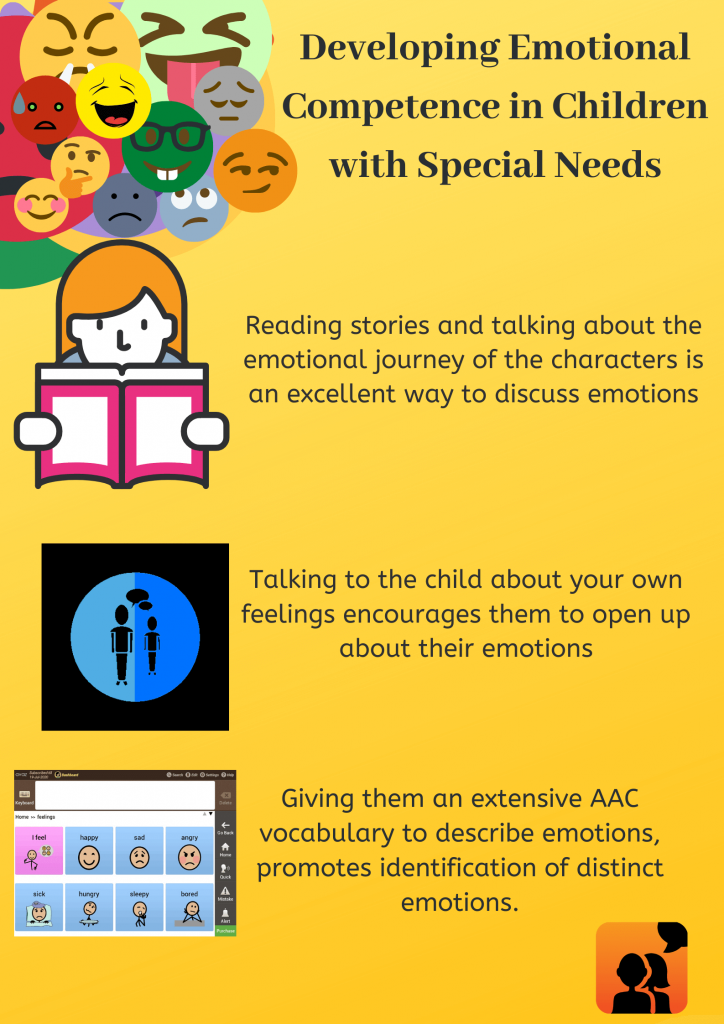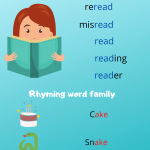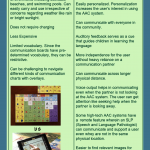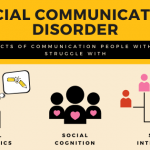How to Develop Emotional Competence of an AAC User
 Emotional competence is the ability of a person to express their own emotions with complete freedom. You can convey emotions without words, but you run the risk of your gestures and facial expressions being misinterpreted. Moreover, non-verbal communication of emotions requires that the communication partner is looking at you, and this can limit your expression.
Emotional competence is the ability of a person to express their own emotions with complete freedom. You can convey emotions without words, but you run the risk of your gestures and facial expressions being misinterpreted. Moreover, non-verbal communication of emotions requires that the communication partner is looking at you, and this can limit your expression.
Language, therefore, plays an instrumental role in determining a person’s ability to effectively communicate their emotions. Over the course of their lives, children and adults may struggle with communicating their emotions. For a child with complex communication needs, the challenge is greater, because they might not have the literacy to convey their emotions accurately. Therefore, AAC intervention programs need to focus on developing their emotional intelligence and provide them the relevant vocabulary.
Components of Emotional Intelligence
Emotional intelligence is essentially the ability to identify emotions and use them appropriately. Since emotional intelligence influences the quality of a child’s relationships and their social life, it is important to understand what we really mean by it.
Here are the key components of emotional intelligence and the corresponding skills we need to foster in children with special needs:
- Self-awareness
Recognizing their emotions and what caused them.
Making the connection between their emotions and behaviour.
Having an awareness of the effects of their emotions.
Knowledge of their strengths and weaknesses.
Ability to learn from mistakes.
Identifying areas of self-development.
Willingness to listen to feedback.
- Emotional Regulation
Controlling impulses and disruptive feelings.
Maintaining composure under distressing situations.
Acknowledging one’stheir mistakes.
Understanding values such as honesty and reliability.
Having the flexibility to deal with change of plans.
Adaptability to new and unfamiliar environments.
- Self-motivation
Setting goals and working towards it.
Having realistic ambitions.
Setting deadlines and meeting them.
Organizing themselves to achieve their goals.
- Empathy
Awareness of others’ emotions.
Ability to feel what others are feeling.
Ability to show concern and care.
Knowledge of appropriate things to say and do, to show concern.
Ability to put aside their priorities to listen to others.
- Social Skills
Actively listening to what others have to say.
Being respectful of others’ emotions.
Ability to show gratitude.
Ability to form friendships.
Being comfortable in social settings.
Emotional Intelligence of Special Needs Children
Teaching emotional skills to any child can be tricky. It can be more difficult for children with special needs because physical deficits and cognitive impairments can affect how well they understand and distinguish the various emotions. Here are a few things to do to help them learn to identify, regulate, and express their emotions.
Read Stories
Reading stories is an excellent way to teach the child to identify the different emotions. As you are reading, talk about the main characters in the story and discuss their feelings. Draw the child’s attention to the change in emotions of the characters throughout the story. If the boy in the story was sad that he couldn’t find his favourite ball, make sure that the child understands the correlation between the event and the emotion. If at the end of the story, the boy is happy that he got a new ball, talk to the child about the shift in the emotional state of the character.
Ask the child what they are feeling about the events in the story. Are they sad that the boy lost his ball? Are they happy that the boy got a new ball? Asking them such questions is a good way to teach empathy to the child.
Encourage the Child to Talk
Children with special needs can get better at talking about their feelings, the more they do it. Asking them questions regularly can help them open up about their emotions. Build on their answers and help them elaborate, and be specific by asking consecutive questions. If you ask ‘How are you feeling now?’, and they answered, ‘Mad’, ask further questions to help them explore their emotions.
‘Why are you mad?”
If the child doesn’t know how to answer the question, you can proceed by giving them possible causes.
‘Are you mad because I asked you to stop watching TV or are you mad because the music is too loud for you?’
Continue the conversation until the child is able to recognize the exact cause of their emotion.
If they indicate that that they do not wish to talk about it, talk to them about some of your experiences in similar situations.
Give Them The Vocabulary
‘I’m excited’ is not the same as ‘I’m happy’. The AAC user should be taught extensive vocabulary to express distinct emotions. The best way for a communication partner to do this is to talk about their own feelings in various situations. If you are taking the child to their favourite movie, you can say ‘I’m excited to watch this movie with you.’ When the child is waiting for his grandparents to arrive, you can say, “Are you excited about seeing grandpa?’ Consistently using the word ‘excited’ both in direct conversation with the child, and conversations with other communication partners familiarizes the child with the word.
Modelling the word in the AAC system whenever you use it, can motivate the child to use the word to express their excitement. Adding too many emotion words at the beginning can be confusing and overwhelming for a user. Start slow, and as the child’s emotional intelligence grows, make sure to include additional words that describe the different emotions.
Visual supports and role play can also help your child develop their emotional competence. If you know of an upcoming or recurring situation that causes emotional upheaval in your child, discuss it in advance. Having a conversation about the event when the child is calmer, helps them understand the situation better. This can help them regulate their emotional response to the event. Each child has different cognitive abilities and emotional awareness. Hence, while teaching children emotional skills, parents and teachers should exercise their judgment. This will help in choosing the method that best suits the child’s needs.
Subscribe to the Avaz Newsletter
Join 4000+ fellow readers! Get latest articles straight to your inbox. Enter your email address below:
Popular Articles
- Building Literacy: Teaching Grammar to AAC Users
- Expansion of Language: Supporting AAC Learner’s Progress
- Avaz User Stories and Videos
- Avaz Joyful Reading: Resources for Shared Reading
- AAC Resources: Games, Activities and Communication Opportunities
- Avaz AAC User Stories: Why Nishant and his AAC System are Inseparable
- Downloadable Low Tech Communication Boards
- Get the Better of Reading Difficulties with MDA Avaz Reader
- AAC Apps for Adults with Acquired Communication Disorders
- Teletherapy: A smart way to facilitate remote speech therapy for adults and children


